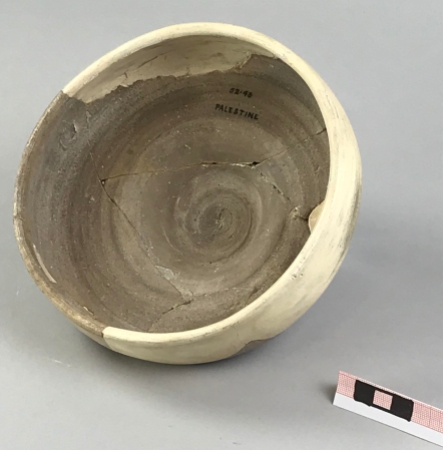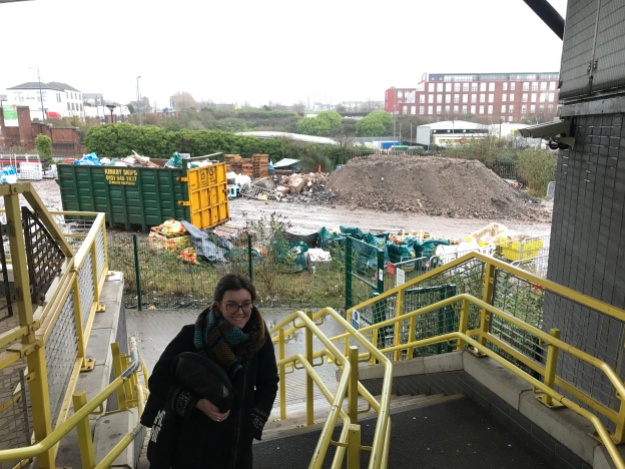See below for a press release following Dennis Mizzi’s presentation of our research paper at ASOR and SBL this week. In this paper we present the results we obtained on analysing the residue found in a jar lid now in the collection of Judith Brown. We are very grateful to her for permitting DQCAAS to take a sample for study.
PRESS RELEASE
A study of ancient residue in a clay jar lid, originally coming from the area where the Dead Sea Scrolls were found, has shown that it contained decomposed papyrus. Numerous cylindrical jars and lids were found in caves close to the ancient site of Qumran, west of the Dead Sea, but these were largely broken and empty, and their association with scrolls has been doubted. The discovery of decomposed papyrus in one of the lids adds to the evidence that scrolls were once placed in them, even when no scroll fragments have survived.
Dr. Dennis Mizzi, of the University of Malta, announced the findings this week on behalf of an international team of researchers, at the American Schools of Oriental Research and Society of Biblical Literature Annual Meetings in San Diego.
The jar lid is now in a private collection. It was bought in 1963 by Scrolls scholar John Allegro, who was told reliably that the object came from the Qumran area. The researchers state in their paper that while the precise find spot cannot be determined exactly, ‘the jar and lid have a condition that would match what we would expect in a cave environment’, and their forms are the same as other Qumran jars and lids, which are of a class not found anywhere else.
John Allegro, the original purchaser, believed that the hardened residue was ‘bat dung’, but – fortunately – he never cleaned it out. A sample was sent for testing at Quest laboratories, at the University of Reading, UK, and the tests have concluded that the unknown material derives from a member of the sedge (Cyperaceae) family, such as the papyrus sedge, which is not local to the Dead Sea area, and therefore ‘probably comes from one or more degraded papyrus scrolls’.
The substance was analysed as an initiative of the Leverhulme-funded ‘Network for the Study of Dispersed Qumran Cave Artefacts and Archival Sources’ (DQCAAS), a collaboration between Prof. Joan Taylor (King’s College London), Dr. Dennis Mizzi (University of Malta), and Prof. Marcello Fidanzio (Università della Svizzera italiana). The scientific analysis was led by Dr. Kamal Badreshany (University of Durham).
The Dead Sea Scrolls are ancient manuscripts written in Hebrew, though some are also in Aramaic and Greek. They contain biblical and other religious writings copied over 2000 years ago, and mystery still surrounds them. The manuscripts were discovered in 11 caves close to Qumran from 1947 to 1956. Usually surviving in fragments, a few well-preserved scrolls were found in cylindrical jars, but there are many other nearby caves in which similar distinctive jars and lids were retrieved, without scrolls.
The new results probably indicate that a jar in a Qumran cave fell over and its papyrus contents spilled into the detached lid, then decomposed over the centuries. The researchers state: ‘Some scholars have long suspected that many other Qumran caves contained scrolls—that the caves with empty cylindrical jars were once scroll caves too … Our results provide further support to this hypothesis.’
Added on 22 January 2020:
By popular demand, the paper delivered in San Diego can be read here:
Allegro Jar and Lid ASOR-SBL final 2019
———————————————
For further enquiries about the jar lid and the results, please contact Prof. Joan Taylor, joan.taylor@kcl.ac.uk









 We extremely grateful to Dr Ashley Cooke (featured in the main post photograph) for making the archival correspondence available to the network team to verify the authenticity of this acquisition, as well as his hospitality at the Museum’s off-site warehouse when Isabella Bossolino and Sandra Jacobs arrived from London to photograph and draw the jar and lid.
We extremely grateful to Dr Ashley Cooke (featured in the main post photograph) for making the archival correspondence available to the network team to verify the authenticity of this acquisition, as well as his hospitality at the Museum’s off-site warehouse when Isabella Bossolino and Sandra Jacobs arrived from London to photograph and draw the jar and lid.















 The Network meeting in Paris was attended by all partners: Joan Taylor, Marcello Fidanzio and Dennis Mizzi, along with Network Facilitator Sandra Jacobs. It was decided in order to have a Network meeting coinciding with practical work visiting the Qurman jar at the Musée du Louvre for close examination.
The Network meeting in Paris was attended by all partners: Joan Taylor, Marcello Fidanzio and Dennis Mizzi, along with Network Facilitator Sandra Jacobs. It was decided in order to have a Network meeting coinciding with practical work visiting the Qurman jar at the Musée du Louvre for close examination. 





